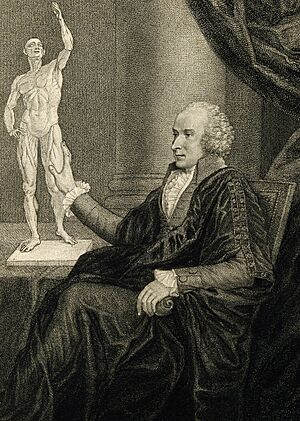Busick Harwood facts for kids
Sir Busick Harwood (born around 1745, died 1814) was an important English doctor. He became a professor at Cambridge University, teaching about the human body.
Contents
Life of a Cambridge Professor
Busick Harwood was born in Newmarket, Suffolk around 1745. He first trained to be a surgeon. After his training, he worked in India as a surgeon. He earned a lot of money there by treating princes. However, his health suffered, so he returned to England.
Education and Discoveries
Back in England, Harwood went to Christ's College, Cambridge. He earned his first medical degree (M.B.) in 1785. Later, he received his M.D. from the University of St Andrews School of Medicine in 1790. He also became a member of important groups like the Fellow of the Society of Antiquaries of London in 1783 and the Fellow of the Royal Society in 1784.
For his M.B. degree, Harwood wrote about blood transfusion. This is when blood is moved from one person or animal to another. He did experiments where he moved blood from sheep to dogs that had lost a lot of blood. He believed that blood transfusions could be very helpful. He wanted to study if diseases or medicines could be passed through transfusions.
Becoming a Professor
In 1785, Harwood became the professor of anatomy at Cambridge. This meant he taught students all about the structure of the human body. In 1800, he also became the Downing Professor of Medicine. He kept both teaching jobs. In 1806, he was given the special title of "Sir" (knighted).
Sir Busick Harwood passed away on November 10, 1814, at Downing College, Cambridge. He was buried in a special vault. He had married in 1798, but he did not have any children.
His Published Works
Sir Busick Harwood wrote a book called A System of Comparative Anatomy and Physiology. The first part of this book was published in 1796. He also wrote notes for his lectures.


